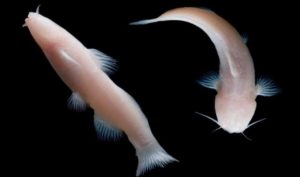
A rare species of blind catfish has been discovered recently in an underwater cave near Del Rio, Texas, by a team of researchers.
These endangered catfish or Mexican blindcat (Prietella phreatophila) are unique in color and size, and were previous known to exist only south of Texas in Mexico.
A pair of these fishes was discovered in May in a limestone cave at Amistad National Recreation Area. This region lies about 150 miles west of San Antonio. The fishes have now been shifted to San Antonio Zoo, although they are not yet on display. A special facility has been designed in the zoo to accommodate cave and aquifer species.
A unique feature of these Mexican blindcat fishes is that they can’t grow larger than three inches. They are pinkish-white in color and have a translucent skin. Mexican blindcat is known to dwell only in areas supported by the Edwards-Trinity Aquifer that underlies the Rio Grande basin in Texas and Coahuila.
Dean Hendrickson, curator of ichthyology at the University of Texas at Austin, has spent many years searching for the Mexican blindcat in the US. He identified these fishes as Mexican blindcats for the team of researchers, and according to him, the discovery of these fishes is the first confirmed blindcat sighting in Texas.
There are now three blind catfish species in the US, all found in Texas. The other two species are widemouth blindcat and toothless blindcat.
“Since the 1960s there have been rumors of sightings of blind, white catfishes in that area, but this is the first confirmation,” Hendrickson said. “I’ve seen more of these things than anybody, and these specimens look just like the ones from Mexico.”
Jack Johnson, a caver and National Park Service resource manager at Amistad, was the first to spot some blind, pinkish-white fish in April 2015. Johnson and biologist Peter Sprouse of Zara Environmental LLC then made many attempts to find the species, and succeeded last month to find the fish again. Others researchers involved in the finding include Andy Gluesenkamp and Ben Hutchins of Texas Parks and Wildlife, Jean Krejca of Zara Environmental and Gary Garrett and Adam Cohen of UT Austin.
“Cave-dwelling animals are fascinating in that they have lost many of the characteristics we are familiar with in surface animals, such as eyes, pigmentation for camouflage, and speed,” Sprouse said.
“They have found an ecological niche where none of those things are needed, and in there they have evolved extra-sensory abilities to succeed in total darkness.”
The Mexican blindcat was first documented in 1954 when some of these fishes were found in springs and wells near Melchor Múzquiz in the northern Mexican state of Coahuila. Mexican government then listed it as an endangered species. These fishes have never been seen this far north, suggesting that underground caverns may be linking Mexico to the US.
“Aquifer systems like the one that supports this rare fish are also the lifeblood of human populations and face threats from contamination and over-pumping of groundwater,” Johnson said.
“The health of rare and endangered species like this fish at Amistad can help indicate the overall health of the aquifer and water resources upon which many people depend.”
According to Danté Fenolio, vice president of conservation and research at the San Antonio Zoo, the zoo “has a series of labs specially designed to keep subterranean wildlife safe and healthy.”
“The fact that the zoo can participate now and house these very special catfish demonstrates the zoo’s commitment to the conservation of creatures that live in groundwater.”
